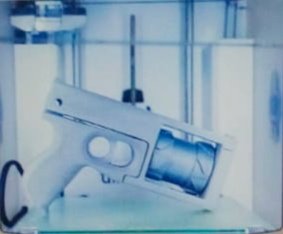3-D printed 'ghost guns' came to in market. TOP NEWS-2019
3-D printed ‘ghost guns’

This gun gives more and interesting chalenges to the investigators and officers.
An assembled plastic revolver sits inside a 3-D printer at the University of Mississippi in Oxford.On
December 17, 2017, police responded to reports of gunshots at a Phoenix apartment. When Cleophus Cooksey Jr. answered the door, his mother and stepfather were lying on the living room floor, shot dead. Police arrested Cooksey.
3-D printed ‘ghost guns’ :-
Te double homicide seemed like an isolated incident, a violent end to a family dispute. But ballistics evidence gathered at the crime scene told an even bigger story.
Firearms leave telltale markings on the bullet and the cartridge case that’s ejected when a pistol or rifle is fired. The U.S. Bureau of Alcohol, Tobacco, Firearms and Explosives catalogs these marks in the National Integrated Ballistic Information Network.
Police had collected cartridge cases from that Phoenix apartment. Within 48 hours, the NIBIN database revealed ballistics matches that linked weapons used in several other murders during the previous three weeks. Cooksey has been charged with killing eight people.
3-D printed ‘ghost guns’ :-
Although not perfect, ballistics evidence helps police pull suspects off the streets. NIBIN has yielded over 110,000 matches since it was launched in 1999. But a new type of gun — made of plastic using 3-D printers — may bring new challenges for forensics experts.
Use of a 3-D printed weapon “would make it very difficult for NIBIN to detect the signature of that weapon,” says Frank Fernandez, a retired police chief based in the Miami area who chairs the firearms committee of the International Association of Chiefs of Police.
Right now, violence involving 3-D printed guns is more of a risk than a reality. The most commonly available 3-D printers, which cost hundreds of dollars, may not print usable guns, and high-end models cost tens of thousands of dollars.
3-D printed ‘ghost guns’ :-
But 3-D printed guns have been confiscated at airport security checkpoints, including a disassembled gun seized July 3 at New York’s LaGuardia Airport. And in February, a Texas man who had been prohibited by a judge from possessing firearms was sentenced to eight years in prison for carrying a hit list and a gun with 3-D printed parts.
As 3-D printers improve and costs come down, some experts worry that more people will decide to print guns. Because knowing how to analyze the evidence 3-D printed guns leave at a crime scene may one day become an important skill, researchers are making and firing plastic guns to figure out the forensics of these DIY weapons.
Parts list
The Liberator handgun is built from mostly plastic parts made with a 3-D printer. A metal nail works as a firing pin to set off the internal explosion when the trigger is pulled. Blueprints for the gun were downloaded about 100,000 times within days of their 2013 release.
3-D printed ‘ghost guns’ Not a plaything:-
At less than a pound, the milk-colored pistol looks and feels like a toy. Its parts are formed from plastic spit out with precision by a 3-D printer. But the device shoots real bullets. With two fingers, analytical chemist Oscar “Beau” Black squeezes the trigger, sending a bullet into a target in a laboratory at the University of Mississippi in Oxford.
After a shooter pulls the trigger on a gun — 3-D printed or conventional — a firing pin sets off an explosive substance, which ignites the gunpowder that’s packaged with the bullet in a cartridge. The resulting pressure pushes the bullet out of the cartridge and through the gun’s barrel. The firing pin leaves a dent on the metal case that holds the cartridge together.
3-D printed ‘ghost guns’ :-
The barrel of a conventional gun typically has spiral “rifling” grooves that spin the bullet to give it more stability during flight. These grooves gouge lines around the circumference of the bullet. The number, angle and direction of the marks may reveal the gun that fired it.
The plastic gun barrels that Black built did not have rifling grooves. But even if a plastic gun did have grooves, the plastic itself would be too soft to dent the bullet.
If a plastic gun were used to commit a crime, tracking down the weapon’s maker and the shooter would not be easy. Unlike conventional firearms, plastic guns have no serial numbers for tracking their source, says James Cizdziel, an analytical chemist at the University of Mississippi, where Black is a postdoctoral fellow. That’s why printed guns are called ghost guns, he says. Plastic guns can also be taken apart and sometimes destroyed by dissolving their parts in solvents, Black adds.
3-D printed ‘ghost guns’ :-
“The reality … is that a 3-D [printed] weapon could potentially circumvent a lot of the [existing] security measures,” including background checks and metal detectors, Fernandez says. “Anyone can make them and [not] have to go through any type of vetting process
THANKS TO GIVE YOUR PRECIOUS TIME GUYS.
Congratulations @kapilg! You have completed the following achievement on the Steem blockchain and have been rewarded with new badge(s) :
You can view your badges on your Steem Board and compare to others on the Steem Ranking
If you no longer want to receive notifications, reply to this comment with the word
STOPDo not miss the last post from @steemitboard: